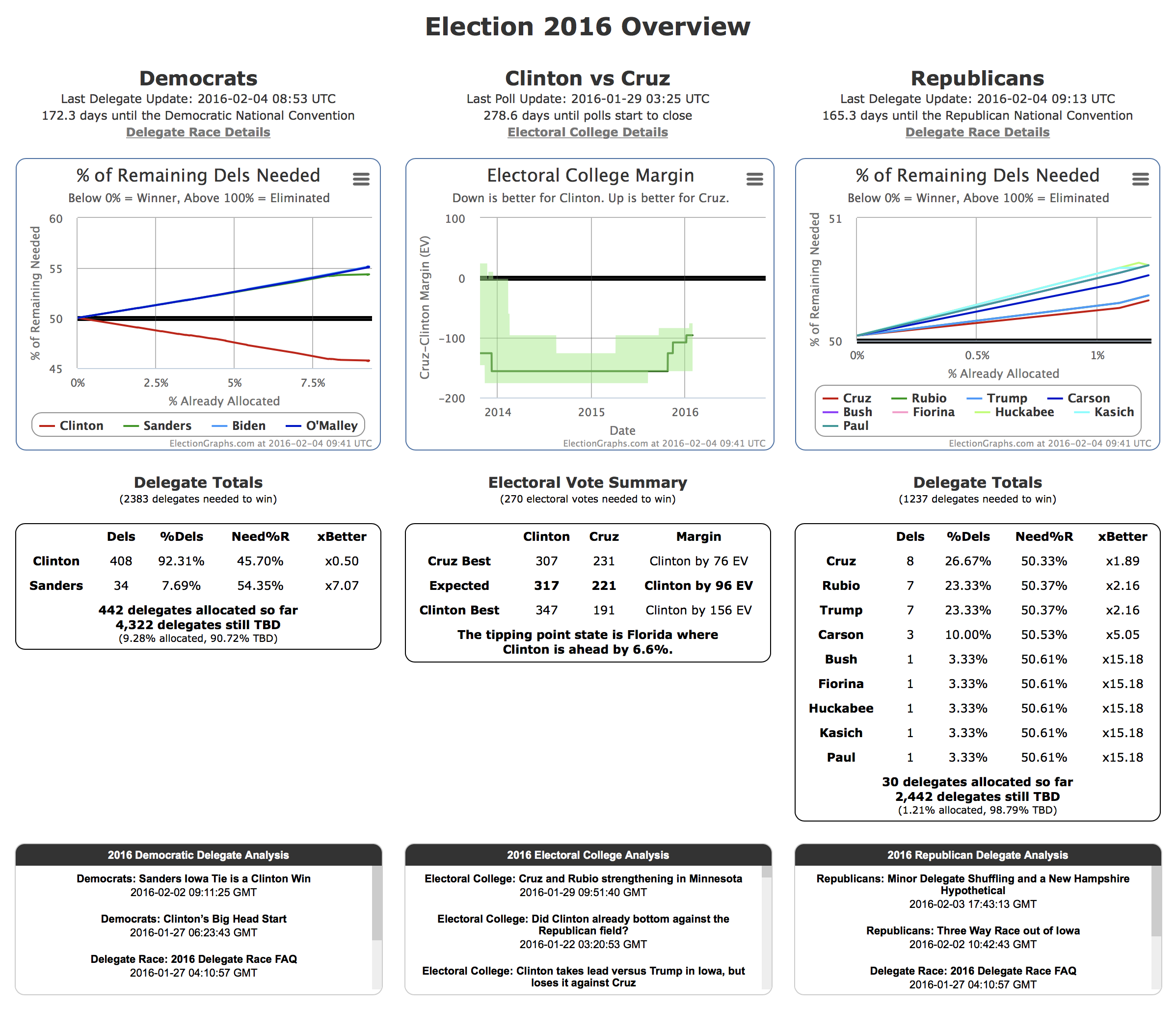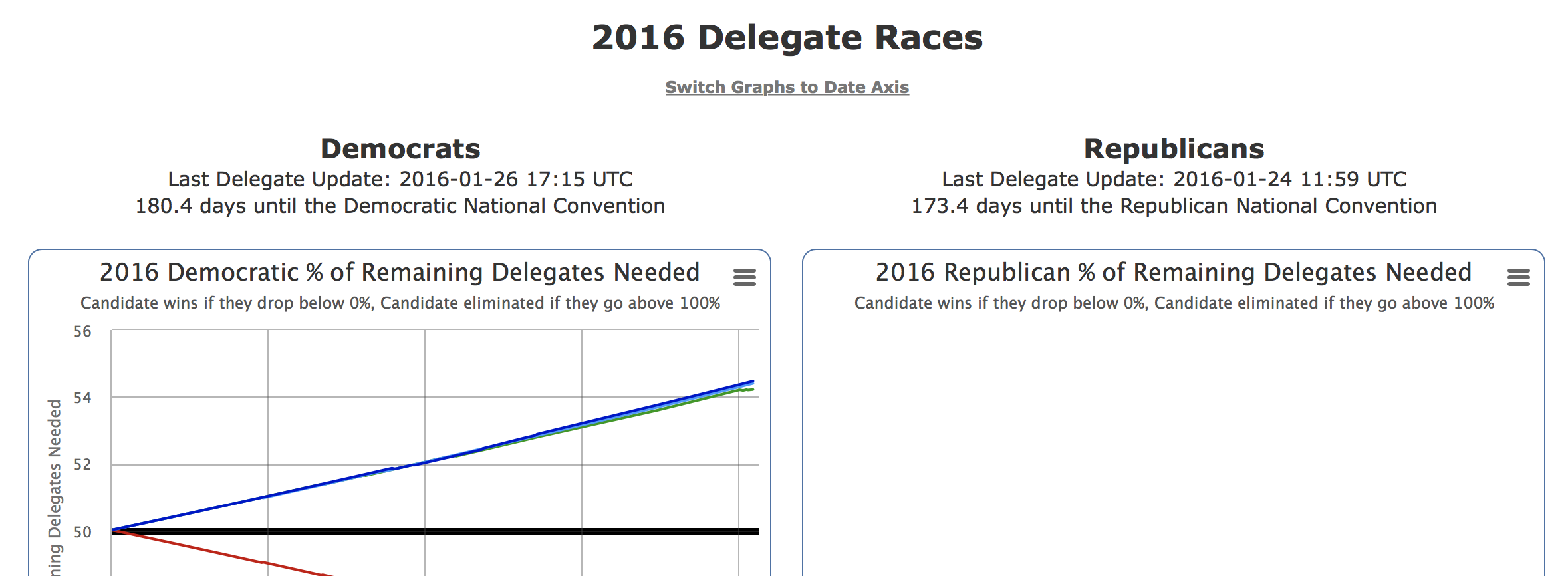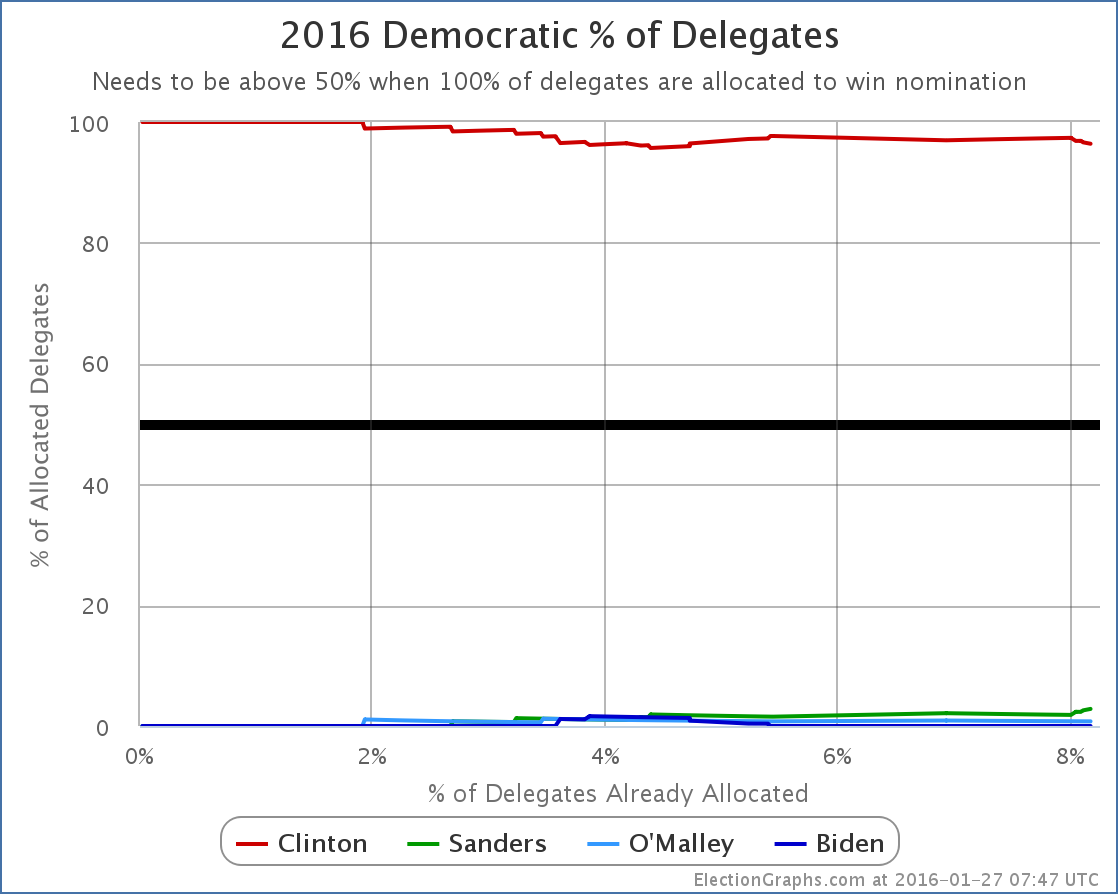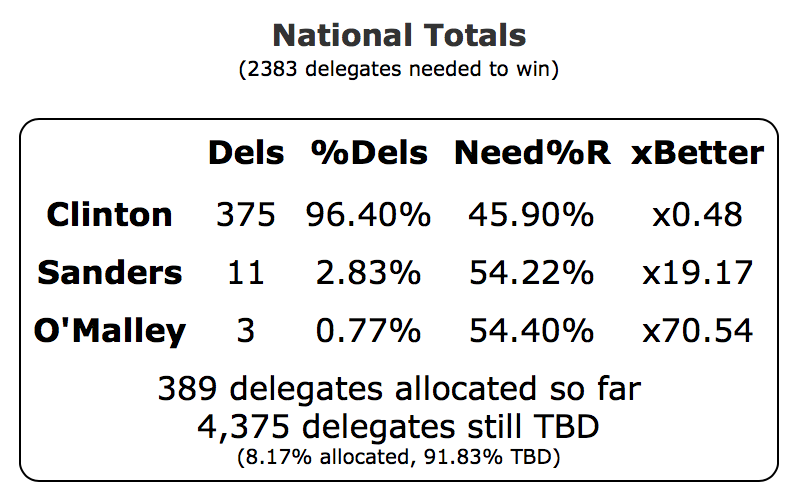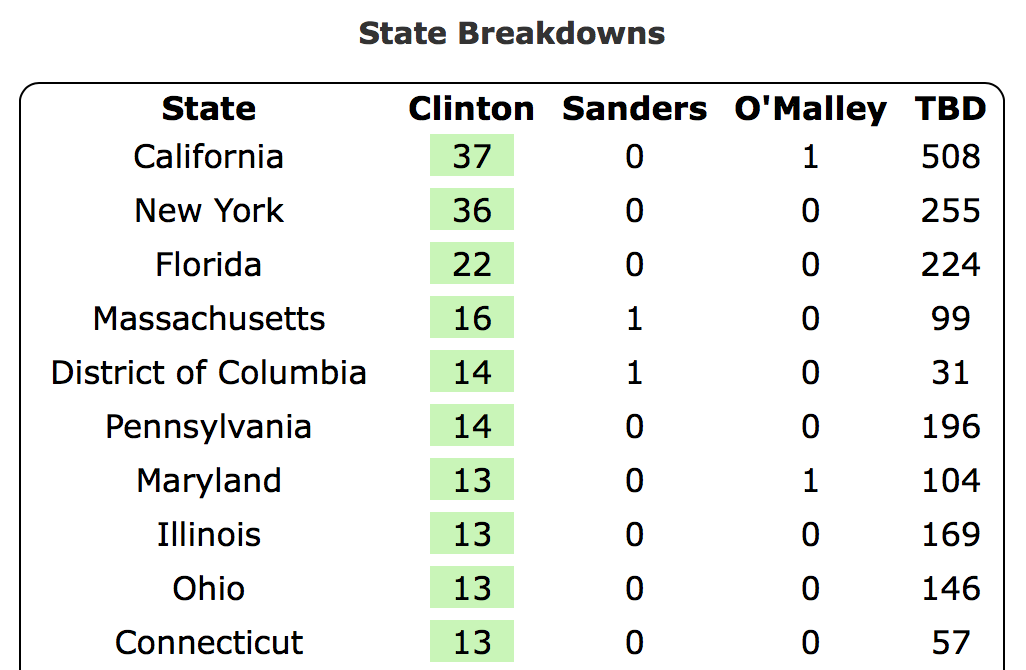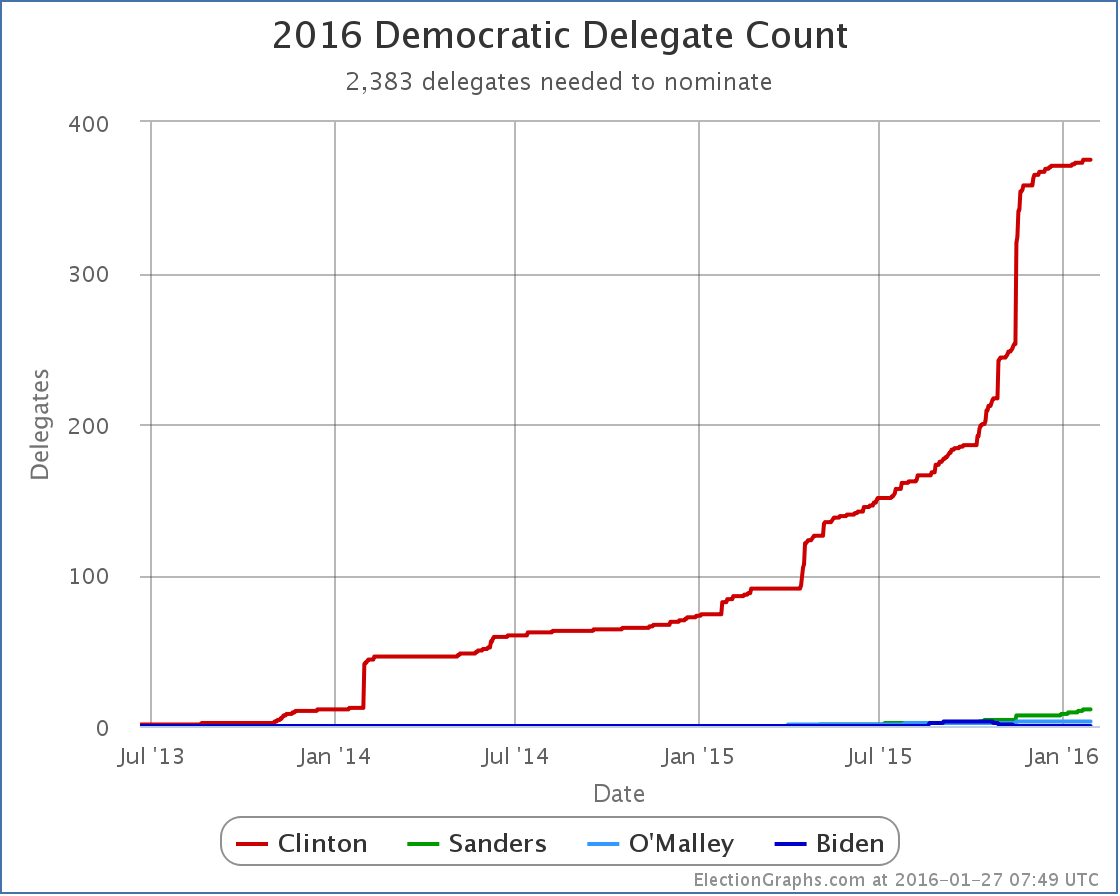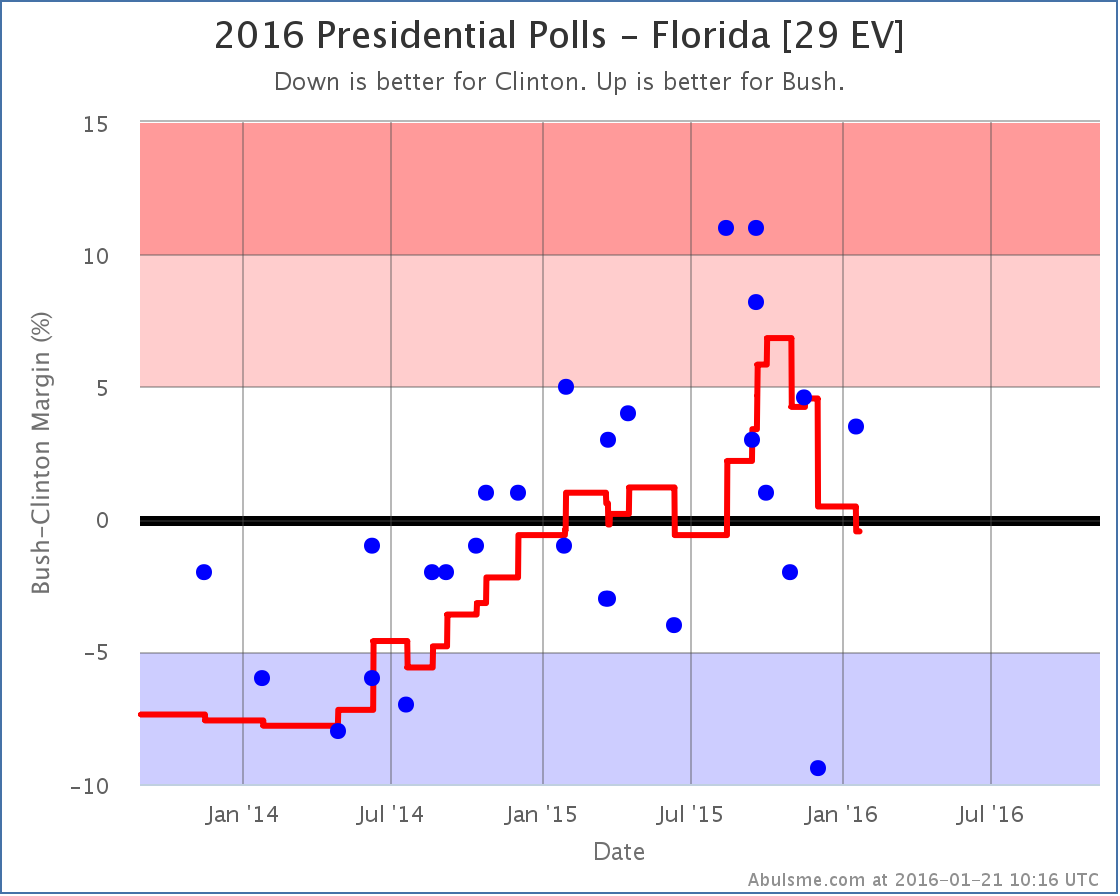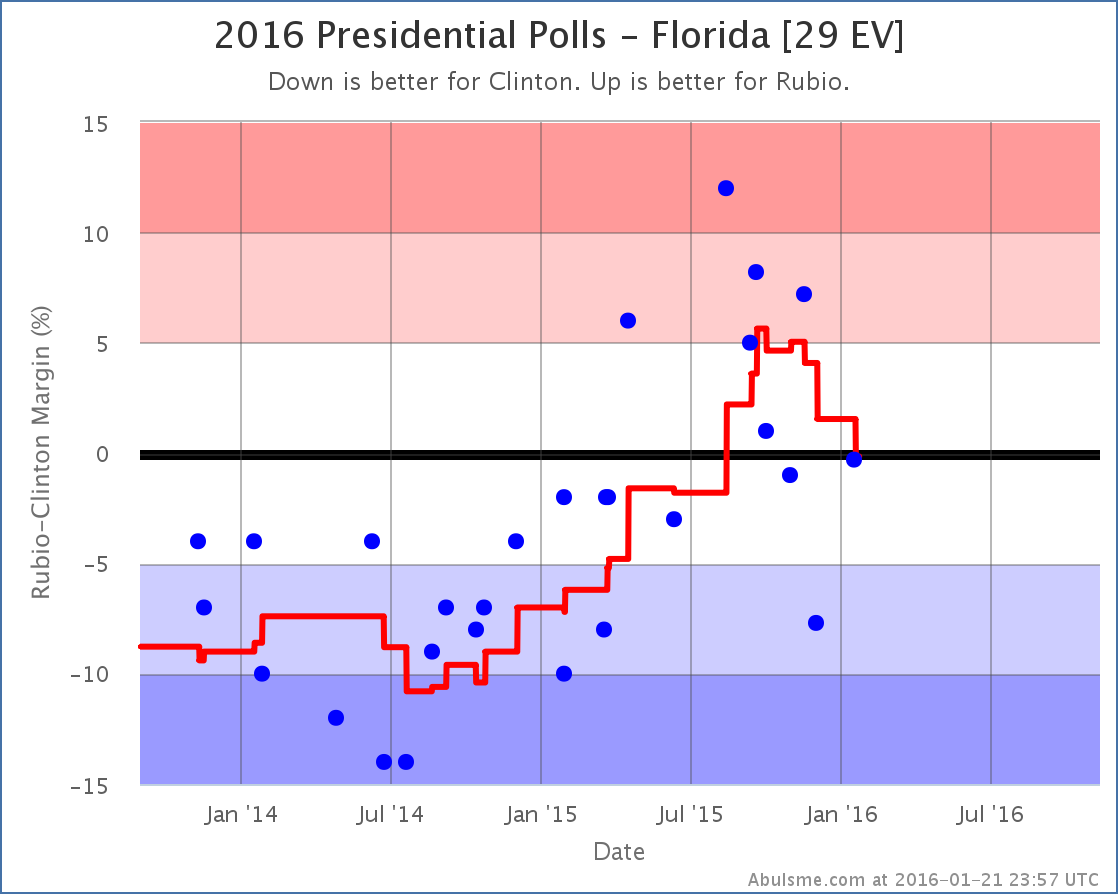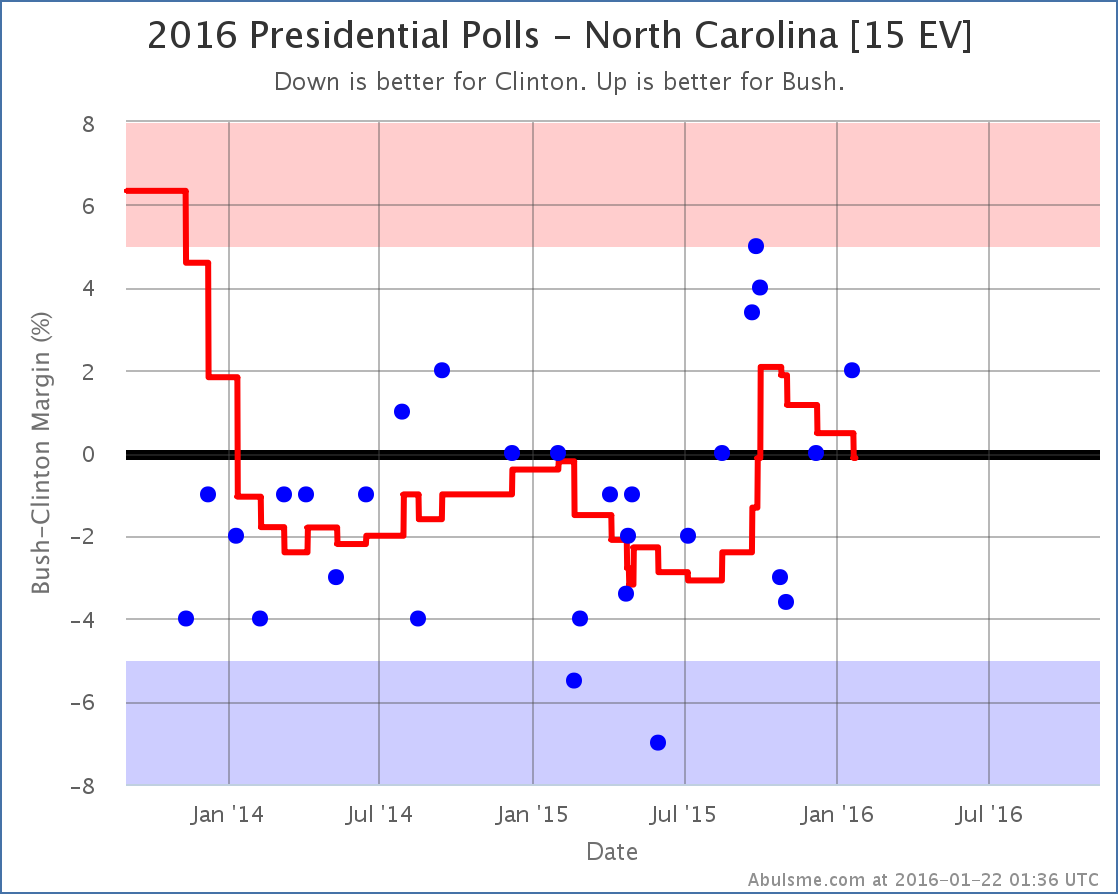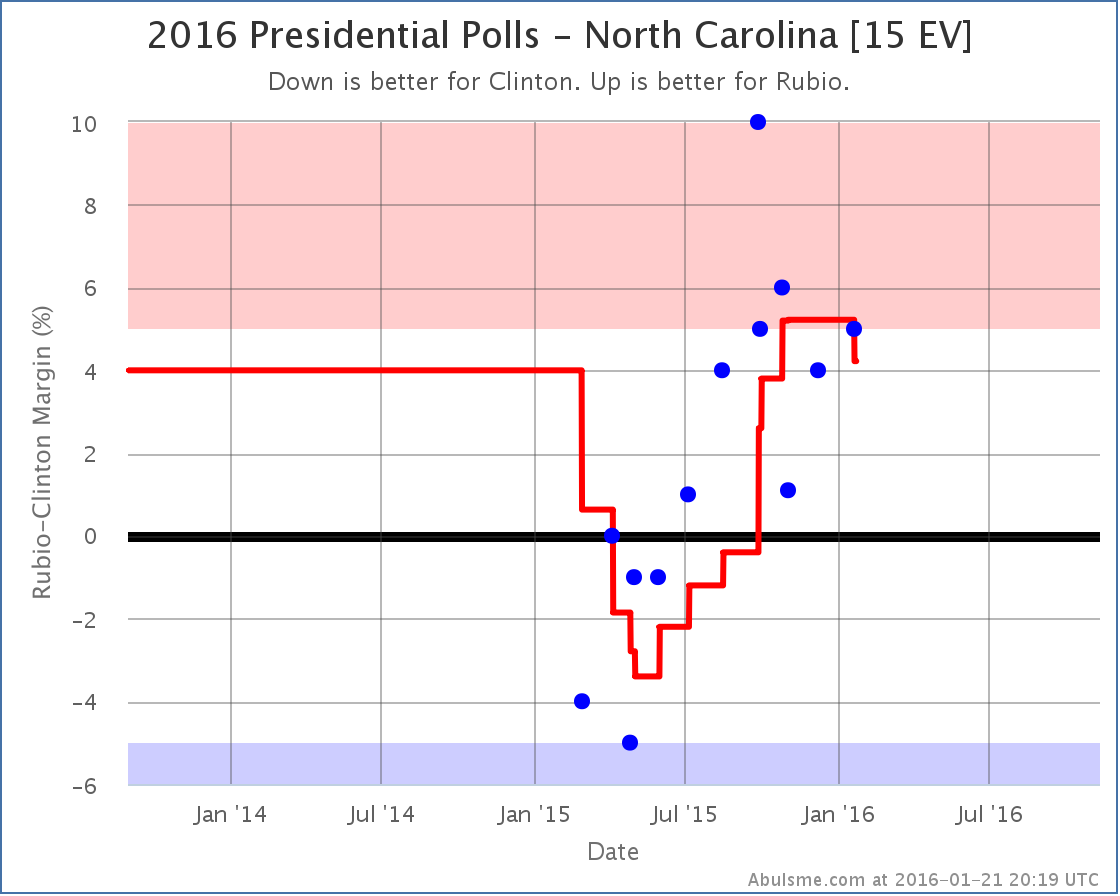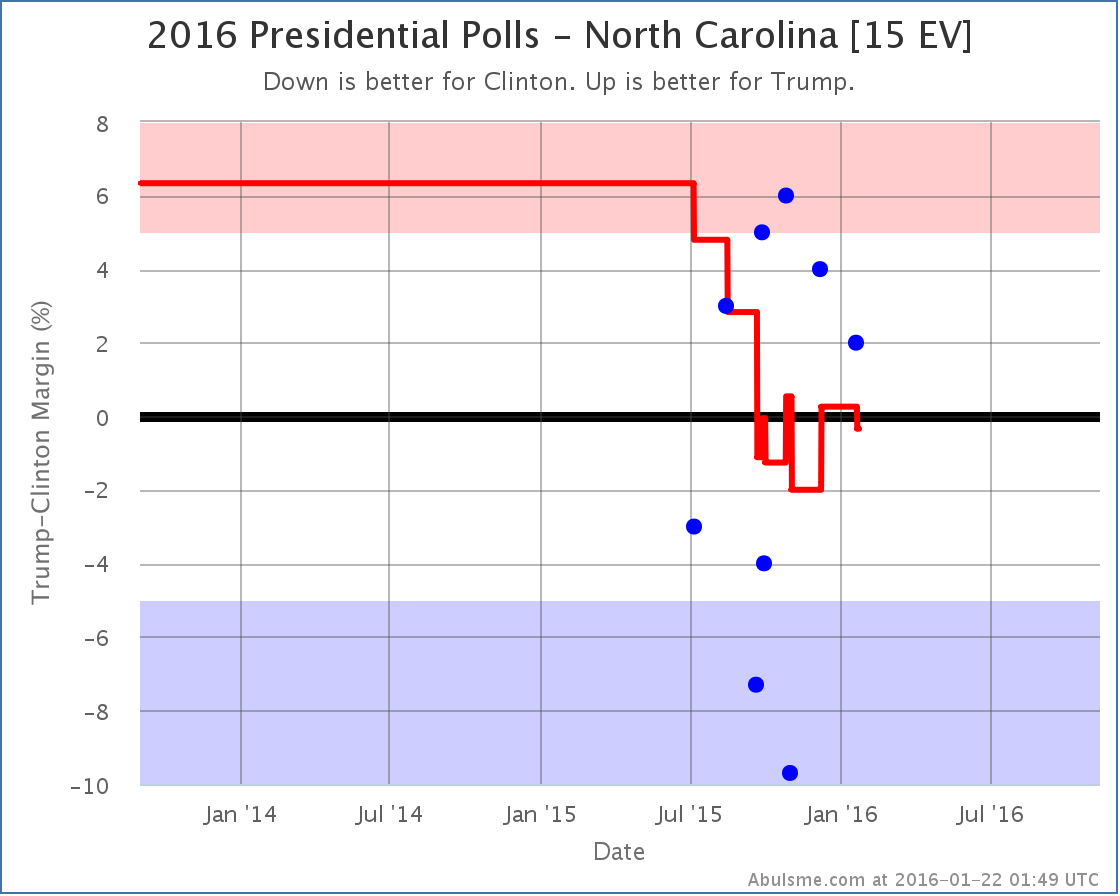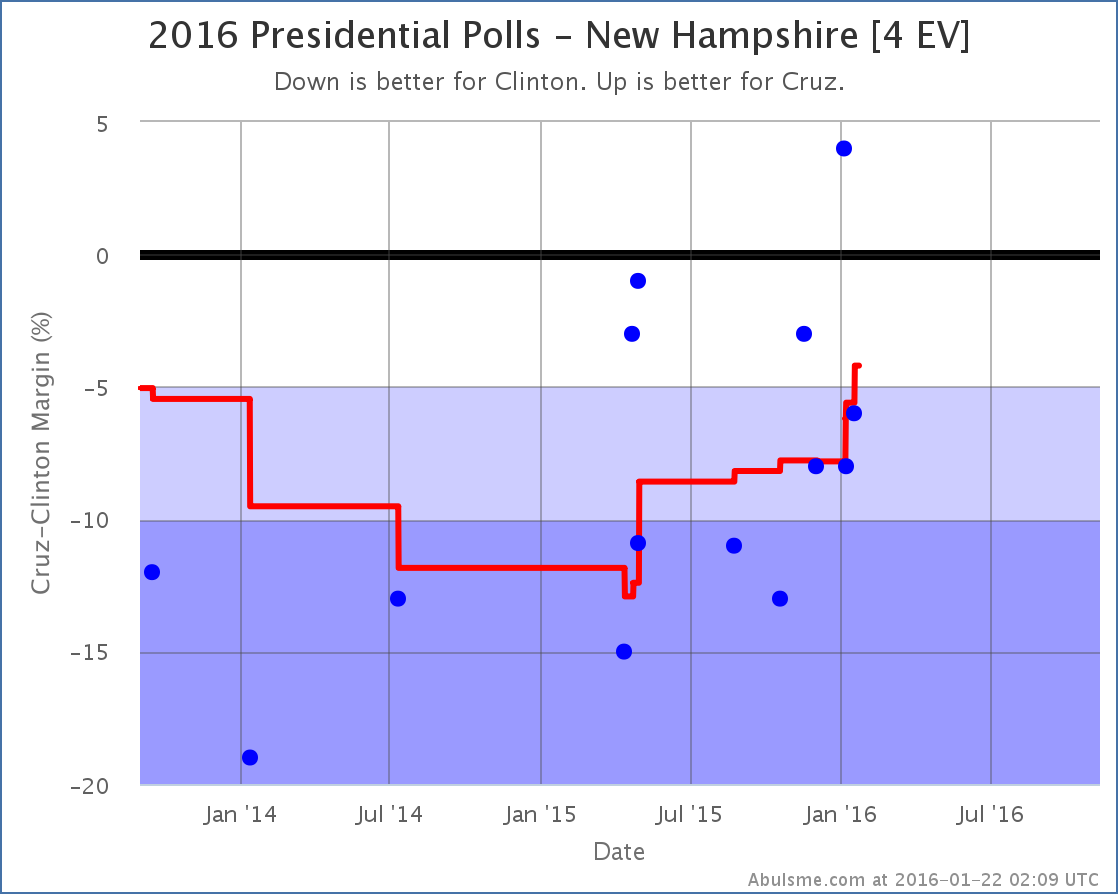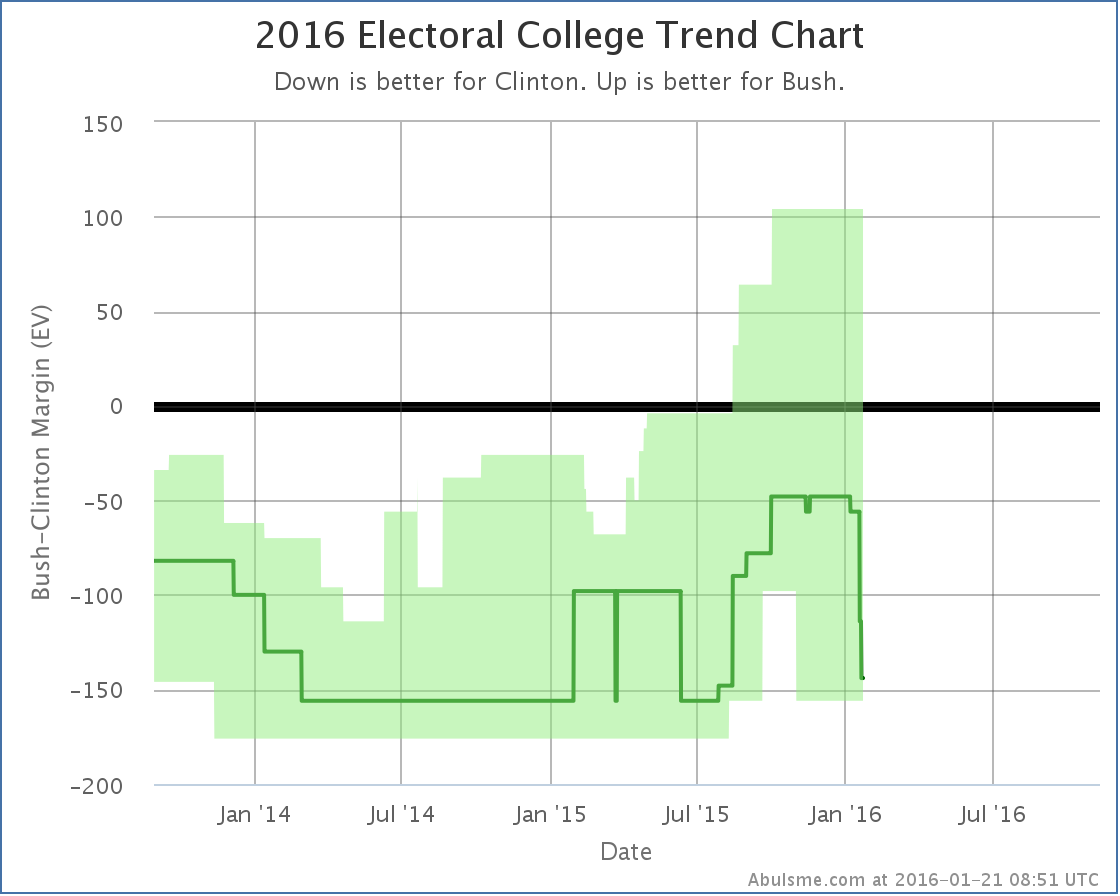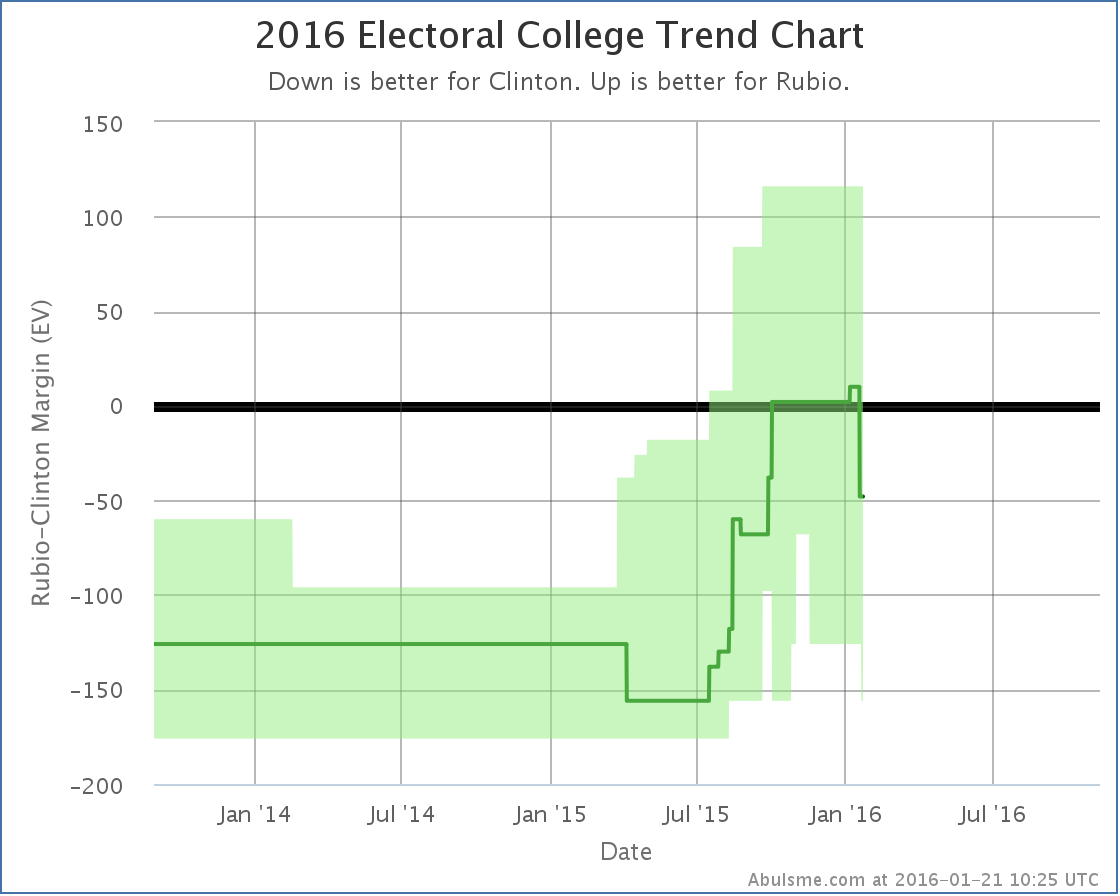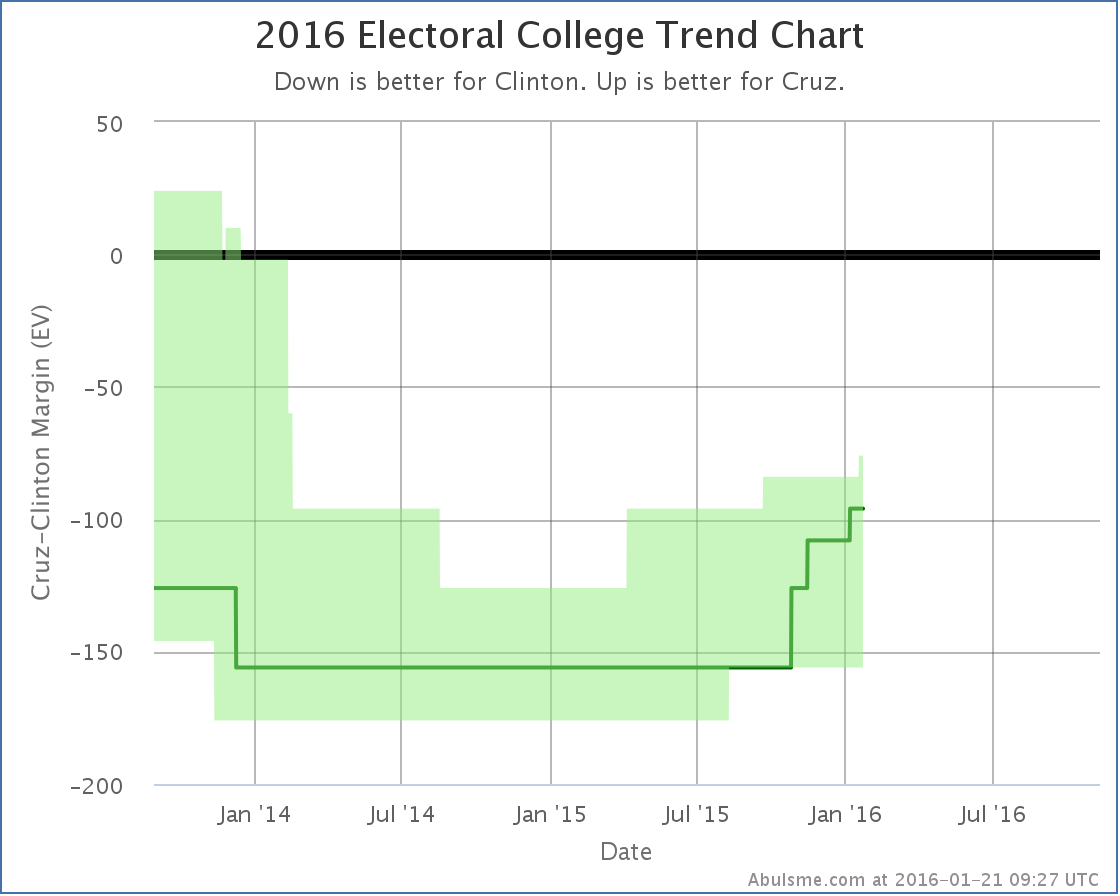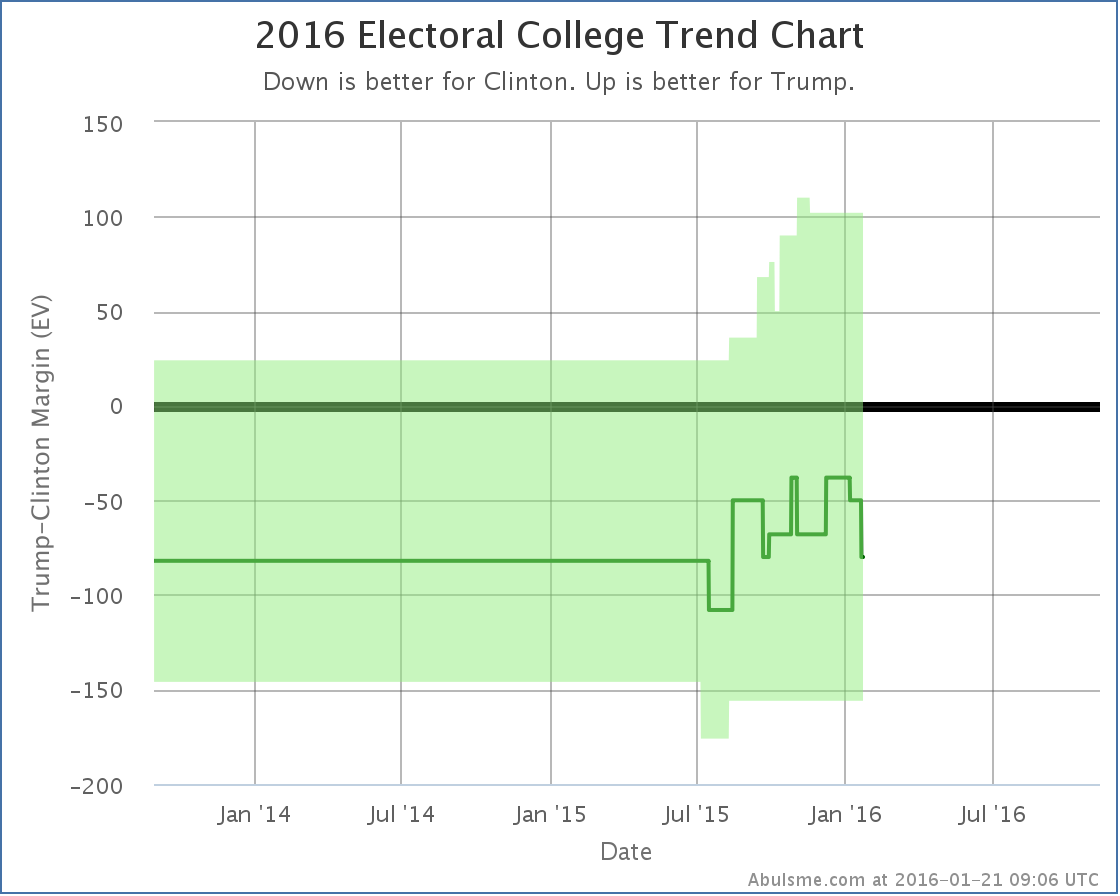- 19:39:44 [Blog post] Delegate Race: Launching the 2016 Delegate Tracker https://t.co/rwg3ixLkAU
|
This post gives an overview of the Election Graphs Delegate Race site for 2016, highlighting the major charts, graphs and features of the site, and how to interpret some of that is there. Or just ignore this and go to the site and explore. But if you want an item by item explanation of what you will see there, then read on. New Overview Page First of all, while not technically part of the Delegate Race coverage pages, I should mention that with the launch of the Delegate Race, the home page of electiongraphs.com has been changed so that rather than just concentrating on the Electoral College race, it gives thumbnail versions of the most important information on both Delegate Races and the Electoral College for the general election. I won’t go over all the specific elements on this page because everything is covered either here or in the Tour of the Electoral College part of the site published back in 2014. From this starting point you can of course easily get to all of the details on both the Electoral College and Delegate Race sides of the site. The candidate combination in the center will be the delegate leaders in both parties as soon as both parties actually have delegate leaders. Until then, it shows the best polled candidate combination. Two Columns The main structure of the 2016 Delegate Races page is two columns. Democrats on the left, Republicans on the right. (Would you arrange them differently? :-) ) Everything on the page runs in parallel for the two parties, showing the same type of data for each. I will use the Democrats as the examples for the rest of this tour, simply because as of a little over a week before Iowa as this is written, there is actual data for the Democrats because of the super delegates who have already expressed a preference, while there won’t be real delegate data for the Republicans until the Iowa caucus results are known. Updates and Countdown The heading should be self-explanatory. :-) A timestamp for the last data update and a count down to the start of the convention. % of Remaining This is one of the critical charts I alluded to in the last post.This shows the percentage of the remaining delegates that each candidate needs to get in order to win the nomination on the first ballot at the convention. On this kind of chart, going DOWN is good. It means you are so far ahead that you only need a small percentage of the delegates that are left to win. Once this number goes to 0%, it means you don’t need any more delegates, you have already won. The flip side of this is that if it goes to 100%, you have been eliminated. You could get every outstanding delegate and it still wouldn’t be enough. And specifically during the contest, at any given time, this number is the level you need to get on each new delegate contest as it comes up to be “on pace” to win. So, for example, with the state of the chart above, you can see that Sanders would need to get a little over 54% of the delegates in the next context (the Iowa caucuses) to be on track to win the nomination. If he got 52% of the delegates, he might well have “won Iowa”, but not by enough. He would actually be in a worse position going into New Hampshire in terms of the delegate race, needing an even higher percentage to be on pace the next time around. Now, that is of course in terms of the pure delegate race. Given the psychology involved, if getting 52% in Iowa was perceived as such a huge win that it boosts his likely delegate haul in New Hampshire from 53% to 60% or some such, then even though the Iowa result put him in a worse position short term, it might boost long term prospects. This is the kind of calculus that occurs during the race, but boosts like that only go so far, in the end watch the math and where this chart goes. Note a situation where ALL candidates go up to 100% rather than one of them heading down to 0%, is exactly the situation that would lead to a so-called “contested convention” where there is no clear winner going into the convention. Delegate Totals The raw estimate of the number of delegates supporting the candidate. This is a “soft count” meaning it includes not just delegates who are formally bound to a candidate, but also unbound delegates who have expressed a preference, and in cases of multi-stage processes, estimates of the final numbers based on the results of the earlier stage. As estimates, these numbers can change, going both up and down as the estimates are refined. Delegate numbers can of course also go down when a candidate drops out and releases their delegates. % of Delegates This is the percentage of the delegates allocated so far that have supported each candidate. This shows how well the candidate is doing so far. It may or may not be directly reflective of how well they will do in the rest of the race. That can be influenced by many factors, but it is reasonable to think that for there to be a dramatic change in performance, there would have to be dramatic events or dramatic differences in the landscape causing the change. Now, as an example, the change from the pre-Iowa world where all the delegates are Democratic insiders to post-Iowa where delegates are actually determined by real people voting is an example of a pretty dramatic change. So for instance, a change from Clinton getting 95%+ of the delegates to something lower would not only not be unexpected, but it would be surprising if such a shift did not happen. This is a second way of looking at how much work a candidate needs to do to win. The percentage of the remaining delegates tells you a lot, but this divides that by how well they have been doing so far, to give a representation of just how much better a candidate has to do in order to catch up and win if they are behind, or how much leeway to do worse a candidate who is on a winning pace has. So, for instance, if so far a candidate has been getting 30% of delegates, but they need 60% of delegates in order to win, then they would need to do 2x better than they have been to win. This chart it shown with an logarithmic scale due to the large range of values seen. Summary Table The site is Election Graphs, and the most important graph is the % remaining graph, so that came first, and I even talked about all the charts lower on the page before mentioning this, but this is the table with all the detailed numbers behind the data, plus some basic numbers around how many delegates have been allocated, how many are left, how many are needed to win, etc. This covers only a snapshot of the numbers at the current time. Historical data is only available in the charts. (Or in the raw data I provide if someone wants to parse it to recreate the time series data.) State Delegate Counts At the bottom of the page is a state by state breakdown of the delegate estimates. The states are listed in order of how many delegates have been allocated so far. The candidate(s) currently leading in each state are highlighted in green. Because of the ways in which delegate allocation works, including the presence of unbound delegates, the delegate leader does not necessarily have to match the winner in the voting reported in primaries and caucuses. And indeed, as seen above, there can be many delegates allocated before any voting takes place at all. Graphs with a Date Axis Looking at the delegate race based on % of delegates allocated does give a better real sense of how far along in the process it really is, but sometimes you just want to see things as they look on a more familiar date axis. At the very top of the page there is a “Switch Graphs to Date Axis” link that shifts all the graphs to be date based instead of percent of delegates based. Once in that mode, you can of course toggle back to the % of delegates view, but you can also toggle between starting the charts whenever the first delegates were logged (so in the case of the Democrats in the 2016 cycle, way back in June 2013) or starting the charts only on the date of the Iowa caucuses (Feb 1st 2016). Links to Blog Posts Oh yeah, and in the middle somewhere there, there are three blocks with links to relevant blog posts. The left and right blocks contain only blog posts with analysis of the delegate race for the parties in that column. The middle block also includes articles on the Electoral College race, episodes of the Curmudgeon’s Corner podcast that talk about the election, and digests of posts made by the @ElectionGraphs and @ElecCollPolls twitter accounts. Notes Finally, at the very bottom of the page are places to follow Election Graphs, some notes about sources, links to raw data, etc. If you are into those things, enjoy. Note: This post is an update based on the data on ElectionGraphs.com. Election graphs tracks both a poll based estimate of the Electoral College and a numbers based look at the Delegate Races. All of the charts and graphs seen in this post are from that site. Additional graphs, charts and raw data can be found there. All charts above are clickable to go to the current version of the detail page the chart is from, which may contain more up to date information than the snapshots on this page, which were current as of the time of this post. Follow @ElectionGraphs on Twitter or like Election Graphs on Facebook to see announcements of updates or to join the conversation. For those interested in individual general election poll updates, follow @ElecCollPolls on Twitter for all the polls as they are added. [Edit 2016-01-27 03:19 UTC to add final note] [Edit 2016-01-27 06:59 UTC to update screenshots to retina resolution] [Edit 2016-01-27 08:06 UTC to update graphs] [Edit 2016-02-02 11:30 UTC to update section on blog post links to reflect split of Democratic and Republican blocks] [Edit 2016-02-04 09:45 UTC to update screenshots for overview page and RSS feeds to reflect current structure] It is just over 7 days until the doors open on the Iowa caucuses for 2016. So it is time to open the Election Graphs delegate tracker. electiongraphs.com/2016delsLong past time actually. At least on the Democratic side, the delegate race actually started long before Iowa. We’ll get into that a bit in a separate post later, but for now, just a quick introduction to what this delegate tracker will and won’t be. The Election Graphs delegate tracker will be based on “soft counts”. While many delegates do get determined directly based on voting results in primaries or caucuses, many do not. There are “superdelegates” who are free agents and can change their minds at any point. There are also processes where the direct voting just elects delegates to a “second stage” who in turn later vote for “a third stage”, etc, until eventually weeks or months later, the actual convention delegates are elected. The degree to which any of this is deterministic varies by state. Here at election graphs we’ll be using a variety of sources to try to understand the preferences of known superdelegates and officially uncommitted delegates, while trying to estimate what the delegate allocation will eventually be at the end of multi-stage processes. This all means that estimates are subject to change and revision. Things are not locked in stone when a winner is declared on a primary election night. In practice though, at least in the last couple of election cycles, tracking these “soft counts” is actually pretty stable. The estimates do adjust a bit as time goes on, but you generally have a pretty good picture of what is going on, and it gives you a better picture than looking only at a “hard count” of delegates who are completely bound to a candidate with no ability to change their vote. Looking narrowly at only that part of the delegate count leaves out a big part of the picture. Lots of places will have delegate counts starting the evening of the Iowa caucuses though, why should you pay attention to the one at Election Graphs? First and most importantly, I track a couple of statistics I have not seen anywhere else. Namely, the percentage of the remaining delegates each candidate needs to capture in order to win, and how much better (or worse) that is than how they have been doing so far. These tell you much more than a raw delegate count, because they also take into account the dwindling number of remaining delegates as things proceed. So, for instance, looking at the famous 2008 Clinton vs Obama race with these metrics it was clear by early March that it was very very unlikely that Clinton would be able to catch up with Obama. Not impossible, but very unlikely, requiring Clinton to do better than she ever had before by a large margin to catch up… a margin that got bigger with every passing contest. Meanwhile the frenzy around the 2008 race continued on and on and on… long after it was clear to anyone really watching the math that it was over. So watch these numbers for an early sense of when the picture is really becoming clear. Second, I also track all of these against the percent of delegates already allocated, not just against the date, which gives you a much better sense of how far along in the process things are, since the delegates available aren’t even remotely close to evenly distributed over time. Third, while lots of places show current delegate counts, very few show you charts of how the delegate race proceeds over time. As they say “past performance does not guarantee future results”, but at the same time, it does give you an idea of the range of what is likely. Sure, something cataclysmic could happen to cause someone who has been routinely getting 60% of the delegates to suddenly only get 10% for the rest of the race, but it is unlikely. It would have to be a result of a massively disruptive change in the race, not the normal ups and downs of a campaign. So watch the time series charts. There are a bunch of other little details here and there that politics and numbers geeks might like too. And of course, it is a chance to support your local neighborhood amateur who does this for fun in their spare time. :-) This is the first of three posts to introduce the delegate tracker, the next will be a “tour” going over all the new features on the site. Note: This post is an update based on the data on ElectionGraphs.com. Election graphs tracks both a poll based estimate of the Electoral College and a numbers based look at the Delegate Races. All of the charts and graphs seen in this post are from that site. Additional graphs, charts and raw data can be found there. All charts above are clickable to go to the current version of the detail page the chart is from, which may contain more up to date information than the snapshots on this page, which were current as of the time of this post. Follow @ElectionGraphs on Twitter or like Election Graphs on Facebook to see announcements of updates or to join the conversation. For those interested in individual general election poll updates, follow @ElecCollPolls on Twitter for all the polls as they are added. [Edit 2016-01-27 03:18 UTC to add final note] [Edit 2016-01-27 08:00 UTC to update graph]
My primary race delegate tracking for both parties will be out very soon… promise. In the mean time, rather than just looking at the delegate leaders on each side against each other, we continue to concentrate on the five best polled candidate combinations. With a batch of new polls added in North Carolina, Florida, and New Hampshire, it starts to look like the long trend of Clinton getting weaker and weaker against a wide variety of Republican rivals may have ended. Maybe. For now. A little bit. Things will change before we are done. Polls like these aren’t predictive of the general election until after the conventions. Caveat caveat caveat. Lets look at each category change by state: Florida (29 EV) Of the best five polled candidate combinations, two Republicans have their positions deteriorate against Clinton in this update, Bush and Rubio: Both candidates seemed to peak in late September or early October, and since then have been weakening. With the latest set of poll updates, both states move from being weakly on the Republican side of the line, to being Weak Clinton. The “weak” here should be emphasized. Clinton’s lead over Bush in the average is only 0.5%, and over Rubio it is only 0.2%. This is about as close as you can get. Since for the analysis here any lead under 5% is considered as one that could easily disappear overnight, at these even smaller margins, this is essentially a tie. But for the last few months, the movement has been in Clinton’s direction. North Carolina (15 EV) In North Carolina, once again Bush and Rubio lose ground to Clinton. Although technically with the current update Clinton vs Trump dropped to the 6th best polled candidate combination, I know the Trumpets will want to hear about how he is doing, so I’ll mention that Trump also weakens in North Carolina. Yes, yes, I know that any such indications are just propaganda from the vast establishment conspiracy of which I am a part. But anyway… looking at the charts: In this case the averages for Bush and Trump against Clinton move from Weak Republican to Weak Clinton, but once again the “weak” is the key here. Clinton leads Bush by 0.1% and Trump by 0.3%. So again, super close. A move from just barely on one side of the line to just barely on the other side of the line isn’t really too meaningful except if it seems part of a larger movement. In the case of Bush, the average seems to have been moving toward Clinton for several months. In the case of Trump, it is more bouncing around in a range over the past few months. Rubio does a bit better here. North Carolina had actually been in the “Strong Rubio” category for a few months, with the poll average showing a Rubio lead of over 5%. With the latest update, Rubio’s lead slips under 5% to 4.2%, which means I once again consider North Carolina a state that could go either way in this matchup, but Rubio still has a lead. New Hampshire [4 EV] New Hampshire is the one state that has good news for the Republicans in this update. No category changes for Bush, Rubio, or Trump… but this time Cruz jumps into a new category. Cruz’s recent movement in New Hampshire is the opposite of the trends we were looking at for the other candidates in the other states. Cruz is gaining on Clinton in New Hampshire. For the first time, the state starts to look competitive in this match up. Clinton is still up 4.2% in the average, but now it is conceivably within reach for Cruz. National Ranges So with all these various changes, what do things look like nationally for all these candidate pairs? Here we go: With Florida and North Carolina back out of his column, the result if everybody just wins the states they are ahead in now sits at Bush losing by 144 electoral votes. If he manages to flip the states where Clinton is ahead by less than 5% he could still win by up to 104 electoral votes though, so while Bush is behind, this is still a race. Before this update, Clinton vs Rubio was actually expected to be a narrow 10 electoral vote Rubio win. But if you take Florida away, that changes into a 48 electoral vote loss. With North Carolina also now considered a possibility for Clinton, Clinton’s “best case” improves to a 156 electoral vote win. Rubio’s best case is still a 116 electoral vote win though, so this matchup is also a real race that could go either way. On the other hand… making New Hampshire possible brings Cruz’s best case… where he wins every state he is ahead in, plus all the states where Clinton’s lead is less than 5%… to Cruz losing by 76 electoral votes. This is better than it was. Cruz has been improving since last spring. But he is still not yet in a place that would make a Clinton vs Cruz race even competitive. Right now that matchup looks like an easy Clinton win. Now, the Real Clear Politics average for Clinton vs Cruz actually shows Cruz ahead of Clinton right now. (Rubio too.) How does this mesh? First thing to note is that the state level polling that the estimates on this site are based on are still not happening quickly enough to show national movement that happens on timeframes less than a few months. So it is quite possible there has been a recent move just isn’t reflected in the state numbers yet. If so, if Cruz ends up the nominee, there will be a lot more polling, and we’ll see the state level analysis move toward the national numbers as more data becomes available. It is of course also possible that Cruz’s support is distributed between states in such a way that gives him a popular vote advantage while still leaving him behind in the electoral college. To be frank though, that is less likely. Given that, it is reasonable to think that perhaps the gains Cruz showed in the New Hampshire update today are quite likely happening in other states as well, there just isn’t the polling available yet to show it on a state by state basis. So Cruz may be stronger than he appears on this chart. There really wasn’t polling on Trump before this summer, so most if not all of the movement seen here is not real movement, but just the process of getting enough polls to have a reasonable picture of how Trump is doing. The “expected” case doesn’t show a real trend, it has just bounced around a bit. Trump’s best case kept improving as more polls became available. At the moment, the state poll averages show a Clinton vs Trump race could reasonably be anywhere from a 156 electoral vote Clinton win to a 102 electoral vote Trump win, with the “expected case” being an 80 electoral vote win by Clinton. But this matchup DOES look like a real race, not a Clinton rout. Trump does better against Clinton than either Cruz or Bush. Of these four, only Rubio does better. Or course, I should repeat all the usual caveats again. See the top of this post. There is still lots of time. Everything can and will change over the next few months. 291.9 days until the polls start to close. 11 days until the Iowa caucuses. This whole thing is going to start moving very quickly very soon. PS for Sanders fans: Although no match up vs Sanders has been polled enough to talk about in detail here, with today’s updates Sanders strengthened vs Rubio in North Carolina, while weakening against both Rubio and Cruz in Florida. Note: This post is an update based on the data on ElectionGraphs.com. All of the charts and graphs seen here are from that site. Graphs, charts and raw data can be found there for the race nationally and in each state for every candidate combination that has been polled at the state level. In addition, comparisons of the best polled candidate combinations both nationally and each in each state are available. All charts above are clickable to go to the current version of the detail page the chart is from, which may contain more up to date information than the snapshots on this page, which were current as of the time of this post. Follow @ElecCollPolls on Twitter for specific poll details as I add them. And like Election Graphs on Facebook!
|
||
